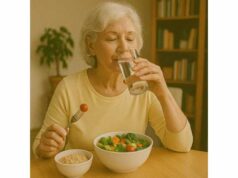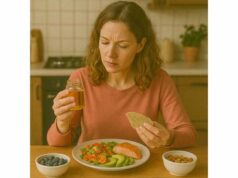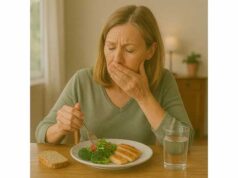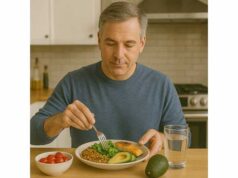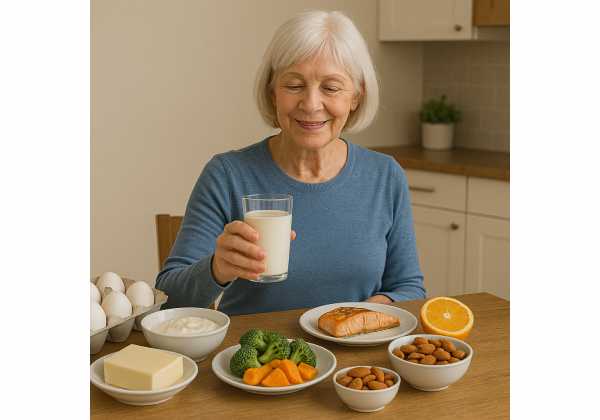
Healthy bones do more than prevent fractures—they support balance, confidence, and independent living. As we age, bone remodeling shifts toward loss, so daily habits matter. Calcium and vitamin D sit at the center of bone nutrition, but they work best inside a complete pattern: steady protein to maintain the collagen scaffold, vitamin K to guide mineralization, magnesium and potassium from plants, smart hydration, and practical meal planning. This guide turns evidence into a week’s worth of food moves. You’ll see which non-dairy foods actually deliver calcium, how to cover vitamin D with food and sunlight basics, ways to boost absorption, and how to hit daily targets without relying on large supplements. We’ll also cover safety notes on upper limits and kidney stone risk, and finish with a shopping list and simple meal ideas. For the bigger picture on how these choices fit a longevity plate, explore our overview of nutrition patterns for healthy aging.
Table of Contents
- Top Calcium Foods Beyond Dairy and How to Use Them
- Vitamin D Foods and Sunlight Basics
- Boosters and Inhibitors of Calcium Absorption
- Daily Targets with Portion Examples
- Pairing Calcium with Protein and Vitamin K
- Safety Notes: Upper Limits and Kidney Stone Risk
- Shopping List and Simple Meal Ideas
Top Calcium Foods Beyond Dairy and How to Use Them
Calcium is the structural mineral of bone, laid down as hydroxyapatite within a collagen matrix. Many people assume dairy is the only practical source. It’s efficient, but not required. If you prefer plant-forward or mixed patterns, the key is choosing foods with absorbable calcium and repeating them through the week.
Non-dairy calcium all-stars (typical values, check labels for exact amounts):
- Calcium-set tofu (look for “calcium sulfate”): ~250–350 mg per 100 g (3.5 oz).
Use it: Stir-fry with bok choy and mushrooms; bake “sheet-pan tofu steaks”; crumble into tomato-olive shakshuka. - Canned fish with bones (sardines, salmon): ~200–325 mg per 85 g (3 oz).
Use it: Sardine-tomato toast with capers and arugula; salmon cakes using canned salmon with bones; add to minestrone. - Fortified plant milks (soy, pea, some almond/oat) and fortified orange juice/cereals: ~120–350 mg per serving.
Use it: A fortified soy latte; pour on high-fiber cereal; blend into smoothies; whisk into savory sauces. - Leafy greens with good bioavailability (bok choy, kale, turnip greens, collards): ~150–250 mg per cooked cup.
Use it: Garlicky sautés; kale-white bean soup; bok choy with ginger over soba. - Seeds and nuts (sesame/tahini, chia): ~60–130 mg per 2 tbsp.
Use it: Tahini-lemon dressing for bowls; chia pudding with berries; sprinkle sesame on roasted vegetables. - Corn tortillas made with lime (nixtamalized): ~80–100 mg per 2 tortillas.
Use it: Fish tacos with cabbage slaw and yogurt-lime sauce. - Blackstrap molasses: ~170 mg per tablespoon.
Use it: Whisk into baked beans or add a small spoon to oatmeal.
What about spinach and beet greens? They contain calcium, but also high oxalates that bind calcium in the gut. Keep them for iron, folate, and flavor, but count on other foods for most of your calcium.
Practical ways to “seed” the day with calcium:
- Morning: Fortified soy or dairy in coffee/tea; yogurt or soy skyr base for breakfast bowls; chia-oat mix prepped overnight.
- Midday: Leafy green plus bean salad with tahini; sardine toast; tofu-vegetable miso bowl.
- Evening: Calcium-set tofu stir-fry; canned-salmon patties with lemony kale; collards simmered with tomatoes and white beans.
Two planning cues:
- Spread intake across meals (300–400 mg at two or three sittings) to improve absorption.
- Read labels on plant milks and cereals; fortification levels vary widely (some brands add tricalcium phosphate; amounts differ by product).
Calcium adequacy is easiest when you build “default” meals you like and repeat. A latte plus yogurt at breakfast, a sardine or tofu anchor at lunch, and a leafy-green or tofu dish at dinner can clear 1,000–1,200 mg without supplements.
Vitamin D Foods and Sunlight Basics
Vitamin D helps shuttle calcium across the intestinal wall and supports normal mineralization. Food provides some vitamin D, but sunlight drives most production for many people—though age, season, latitude, skin pigmentation, and sunscreen use each reduce cutaneous synthesis. The goal is sufficiency, not maximal numbers.
Food sources (typical amounts vary by species and preparation):
- Fatty fish (salmon, mackerel, herring, sardines): often 300–600 IU (7.5–15 mcg) per 100 g serving; some wild salmon can be higher.
- Cod liver oil (small doses): very rich, but consider vitamin A content if used.
- Egg yolks: ~40–50 IU per large egg (more in omega-3–enriched eggs).
- Fortified foods: many milks and plant milks provide 100–150 IU (2.5–3.75 mcg) per 240 mL; some yogurts and cereals are also fortified—check labels.
- Mushrooms exposed to UV light**:** amounts vary; verify on package.
Sunlight basics:
- Cutaneous production depends on UVB reaching the skin. In late fall through early spring at higher latitudes, the UVB angle may be insufficient for meaningful synthesis.
- Older skin synthesizes vitamin D less efficiently. People with darker skin need longer exposure for the same synthesis.
- Sensible, brief exposure to arms and legs can contribute, but sun safety takes priority. If you minimize sun exposure (protective clothing, sunscreen), plan to cover vitamin D through diet and, if needed, supplementation guided by labs.
Supplements when appropriate:
- Many adults reach sufficiency with 1,000–2,000 IU (25–50 mcg) daily, but needs vary by baseline status, body size, and medications.
- Intermittent very high doses are usually unnecessary.
- Coordinate testing (25-hydroxyvitamin D) and dosing with a clinician, especially if you have malabsorption, kidney or liver disease, or take medications that interact with vitamin D.
Putting it on the plate:
- Two to three fish meals weekly plus fortified foods most days cover many people’s needs. If you avoid fish, consider algal DHA for brain/lipid support and discuss vitamin D dosing with your clinician. For choosing seafood or algae sources, scan our quick guide to fish and algae choices.
Red flags for testing:
- Frequent falls, bone pain, minimal sun exposure, darker skin tone with indoor lifestyle, obesity, malabsorption (e.g., celiac, IBD), or medications that affect vitamin D metabolism (glucocorticoids, anticonvulsants).
A simple cadence: test once, correct if needed, and then maintain with food patterns and modest supplementation rather than chasing high targets.
Boosters and Inhibitors of Calcium Absorption
You can eat “enough” calcium on paper and still come up short if absorption is poor or intake is clumped into a single bolus. Think like a builder: provide steady supplies, reduce friction, and give the right co-factors.
Boosters:
- Vitamin D sufficiency. The main gatekeeper for active calcium transport in the gut.
- Moderate, repeated doses. Aim for 300–400 mg calcium with two to three meals rather than a single 1,000 mg hit; fractional absorption drops as dose size rises.
- Protein adequacy. Protein supports the collagen matrix of bone and, within a balanced diet, does not harm calcium balance. Combine calcium foods with protein (yogurt + nuts; tofu + greens; salmon + beans).
- Prebiotic fibers and ferments. A diverse plant pattern (beans, oats, onions, bananas) and fermented foods (yogurt, kefir, kimchi, miso) help generate short-chain fatty acids that may improve mineral absorption and gut comfort.
- Magnesium sufficiency. Magnesium participates in vitamin D metabolism and bone cell function; it pairs well with calcium-rich meals. If you want a focused food list, see magnesium-rich choices.
Inhibitors (and what to do about them):
- Oxalates (spinach, beet greens, Swiss chard): bind calcium in the gut, reducing absorption. Enjoy for other nutrients, but don’t count them toward your calcium total.
- Phytates (bran, some legumes, seeds): can reduce absorption when large amounts are eaten in low-calcium meals. Soaking, sprouting, fermenting (e.g., sourdough) and cooking reduce phytate levels; pairing with calcium-rich foods also helps.
- Excess sodium. High sodium intake increases urinary calcium losses over time. Keep packaged foods and restaurant sodium modest; season with herbs, citrus, and vinegar.
- Very high caffeine (≥400 mg/day) without adequate calcium may increase urinary losses; pairing coffee/tea with a calcium source helps.
- Large iron or zinc supplements taken with calcium can compete for transporters. Separate high-dose pills by a few hours when possible.
- Proton pump inhibitors (long-term) can impair absorption from some calcium forms; calcium citrate is better absorbed with low stomach acid than calcium carbonate.
Form matters when supplementing:
- Calcium citrate absorbs well with or without food and suits those with lower stomach acid.
- Calcium carbonate is best taken with meals.
- Limit single doses to ≤500 mg elemental calcium to keep absorption efficient and reduce GI side effects.
Remember the “absorption ladder”: sufficiency of vitamin D and magnesium, moderate doses of calcium spread through the day, and cooking or pairing strategies that minimize oxalate/phytate drag. Over weeks, these small edges compound into better bone economics.
Daily Targets with Portion Examples
Numbers guide planning; routines make them real. Typical daily calcium targets:
- Adults 19–50 years: ~1,000 mg/day
- Women 51+ and men 71+: ~1,200 mg/day
- Upper limit (adults 51+): ~2,000 mg/day from food + supplements
Vitamin D targets and dosing vary with baseline status. Many adults maintain sufficiency with 1,000–2,000 IU (25–50 mcg) daily, but testing and clinical context should individualize care.
Portion examples that add up (pick 3–5 lines to hit your number):
- 1 cup fortified soy or dairy milk = ~300 mg
- 6 oz (170 g) plain yogurt or soy skyr = ~250–300 mg
- 100 g (3.5 oz) calcium-set tofu = ~250–350 mg
- 85 g (3 oz) canned salmon with bones = ~200–300 mg
- 1 cup cooked kale/collards/bok choy = ~150–250 mg
- 2 tbsp tahini = ~120–130 mg
- 2 nixtamalized corn tortillas = ~80–100 mg
- 30 g almonds or sesame seeds = ~70–100 mg
Two sample days
Food-flexible day (~1,100–1,250 mg calcium):
- Breakfast: Greek yogurt (300 mg) with berries and walnuts; coffee with ½ cup fortified soy (150 mg).
- Lunch: Sardine-tomato toast (200–250 mg) with arugula salad.
- Snack: Kefir (250 mg).
- Dinner: Tofu-bok choy stir-fry (250–300 mg) with brown rice.
Plant-forward day (~1,050–1,200 mg calcium):
- Breakfast: Fortified soy smoothie (300 mg) with oats, spinach (for folate), and chia.
- Lunch: Kale-white bean soup (200 mg) + tahini-lemon drizzle on roasted carrots (60–100 mg).
- Snack: Calcium-fortified cereal (150–200 mg) with fortified soy (150 mg).
- Dinner: Baked tofu “steaks” (250–300 mg) over quinoa and garlicky greens.
Vitamin D rhythm:
- Plan two to three fish meals weekly (salmon, sardines, mackerel, herring).
- Use fortified foods most days.
- Discuss testing and a maintenance dose with your clinician if you get little sun or avoid fish.
Supplement “top-up” approach:
- If diet delivers 800–1,000 mg calcium/day, a 200–400 mg calcium supplement can close the gap.
- Keep single doses ≤500 mg, and reassess once food routines are steady.
If organizing these pieces feels daunting, batch the building blocks once or twice weekly—beans, grains, roasted vegetables, tofu or canned fish—and then assemble fast meals. For step-by-step batching, see our guide to simple meal prep for longevity.
Pairing Calcium with Protein and Vitamin K
Bone is not just mineral. About one-third of bone mass is a protein scaffold (largely type I collagen). Calcium and phosphate mineralize that scaffold. Vitamin K activates proteins (like osteocalcin and matrix Gla protein) that bind calcium where it belongs and help prevent inappropriate calcification in soft tissues. When these three elements line up—calcium, protein, and vitamin K—bone gains a structural advantage.
Protein: the scaffold builder
- With aging, anabolic resistance blunts muscle’s response to small protein doses, so aim for 25–35 g protein per meal (about 1.0–1.3 g/kg/day overall for many older adults, individualized by clinicians).
- Protein adequacy supports the collagen matrix, maintains muscle (which protects against falls), and can improve intestinal calcium absorption when diet quality is high.
- Practical anchors: Greek yogurt or soy skyr at breakfast; salmon, sardines, or beans at lunch; tofu or tempeh at dinner; add a small whey or soy isolate smoothie if meals are light.
Vitamin K: the calcium “traffic director”
- K1 (phylloquinone) lives in leafy greens and plant oils; K2 (menaquinones) appears in fermented foods (natto), some cheeses, and animal products.
- Regular leafy greens cover K1 needs; periodic K2 sources add diversity. If you use warfarin or other vitamin K–antagonist anticoagulants, keep vitamin K intake consistent and coordinate changes with your prescriber.
- For a focused roundup of food sources and how to use them, see our concise explainer on dietary K2 options.
Plates that combine all three:
- Salmon + kale salad with tahini-lemon dressing (calcium, protein, K1).
- Tofu–miso bowl with napa cabbage and mushrooms (calcium-set tofu + K1 from greens + fermented flavors).
- Sardine–white bean bruschetta on whole-grain sourdough with parsley-capers and arugula (calcium from bones, protein, K1).
- Yogurt-topped lentil stew with a side of garlicky collards (calcium + protein + K1).
A note on supplements: In community-dwelling adults without deficiency, routine high-dose vitamin D and calcium pills are not a guaranteed fracture solution. The durable gains come from diet quality, resistance and balance training, fall-proofing the home, and (when indicated) pharmacologic therapy for osteoporosis.
Bottom line: aim for protein + produce + calcium source at each meal. That pattern quietly reinforces mineralization, preserves muscle, and reduces fall risk over time.
Safety Notes: Upper Limits and Kidney Stone Risk
More is not always better. Safety means meeting needs without overshooting and paying attention to individual risk factors.
Upper limits (adults):
- Calcium: ~2,500 mg/day (ages 19–50), ~2,000 mg/day (ages 51+). This includes diet + supplements. Exceeding limits regularly—especially via supplements—may increase kidney stone risk in susceptible people and can cause GI side effects.
- Vitamin D: 4,000 IU (100 mcg)/day as a general tolerable upper intake level in adults. Vitamin D toxicity is uncommon but serious; it’s usually from excessive supplement dosing, not food or sunlight.
Kidney stones:
- Dietary calcium with meals can reduce oxalate absorption and is generally protective for calcium oxalate stone formers.
- High-dose calcium supplements (especially away from meals) may increase stone risk in some individuals. If you need a supplement, keep doses small, take them with food, and discuss with your clinician—particularly if you’ve had stones.
- Vitamin D therapy can raise calcium absorption; in predisposed individuals, high doses may elevate urinary calcium. Pair vitamin D decisions with lab monitoring if you have a stone history.
Sodium and hydration matter:
- High sodium intake increases urinary calcium losses. Favor home-cooked meals, reduced-sodium staples, and herb-forward seasoning.
- Aim for consistent hydration tuned to your climate, size, and activity; more uniformly dilute urine lowers stone risk. For practical targets and electrolyte details, see our overview of hydration and electrolytes.
Drug and disease interactions:
- If you take thiazide diuretics, your clinician may adjust calcium or vitamin D.
- Proton pump inhibitors can reduce absorption of carbonate salts; citrate supplements absorb better.
- Hyperparathyroidism, sarcoidosis, granulomatous diseases, chronic kidney disease, or malabsorption require individualized plans and closer monitoring.
Testing cadence:
- Consider 25-hydroxyvitamin D testing if you have risk factors (limited sun, darker skin, malabsorption, obesity, bone pain, frequent falls) or plan to use supplements.
- For stone formers, clinicians may order 24-hour urine testing to tailor diet (calcium, citrate, sodium, fluids) and determine whether supplements are appropriate.
Safety is a spectrum. Diet-first patterns with modest, targeted supplements—plus attention to sodium and fluids—cover most people’s needs without nudging risk upward.
Shopping List and Simple Meal Ideas
Turn goals into a cart you can repeat. The aim is friction-free: stock a few defaults in each category so calcium and vitamin D show up without extra thought.
Calcium anchors
- Calcium-set tofu (firm or extra-firm)
- Canned salmon and sardines with bones
- Fortified plant milks (soy or pea for protein; check calcium 25–35% DV per cup)
- Plain yogurt, kefir, or soy skyr
- Leafy greens: kale, collards, bok choy, turnip greens
- Tahini, sesame seeds, almonds, chia seeds
- Nixtamalized corn tortillas; fortified cereals (look for ≥10–15% DV calcium per serving)
Vitamin D and partners
- Salmon, sardines, mackerel, herring
- Eggs (consider omega-3–enriched)
- UV-exposed mushrooms (labeled)
- Algal DHA (if avoiding fish; supplement)
- Extra-virgin olive oil (daily use, dark bottle)
Support crew (absorption, synergy, and flavor)
- Beans and lentils (canned low-sodium or dried)
- Whole grains: oats, barley, farro, buckwheat, brown rice
- Citrus, garlic, onions, herbs, vinegars
- Fermented foods: yogurt/kefir, kimchi/sauerkraut, miso, tempeh
- Nuts and seeds: walnuts, pumpkin seeds, sesame, almonds
- Spices: smoked paprika, cumin, turmeric, chili, pepper blends
Seven simple meals (mix and match):
- Sardine-tomato toast on whole-grain sourdough with capers and arugula.
- Tofu-bok choy stir-fry with ginger-garlic and a splash of tamari; side of brown rice.
- Kale-white bean soup finished with lemon and EVOO; sprinkle of parmesan or nutritional yeast.
- Salmon and roasted vegetables (broccoli, carrots) with herb-yogurt sauce; small portion of potatoes tossed in EVOO.
- Greek yogurt bowl (savory): dill, cucumber, cherry tomatoes, and chickpeas; seeded toast with tahini.
- Tempeh–miso noodle bowl with buckwheat soba, mushrooms, and spinach (count spinach for iron/folate, not for calcium).
- Chia-oat overnight cup made with fortified soy; top with berries and almonds.
Batch-prep for less effort:
- Cook a pot of white beans and lentils; roast a tray of mixed vegetables; make two grains (e.g., barley and brown rice).
- Bake marinated tofu slabs and keep canned fish in the pantry.
- Stir together a tahini-lemon dressing and a yogurt-herb sauce; both elevate bowls all week.
- Pre-portion nuts and seeds into small containers for quick snacks.
A week at a glance (calcium rhythm):
- Breakfast defaults: yogurt/soy skyr; fortified soy latte; chia-oat cup.
- Lunch anchors: sardine toast; tofu-grain bowl; kale-bean soup.
- Dinners: tofu stir-fry; salmon with greens; tempeh noodle bowl; white-bean-veg skillet.
- Snacks: kefir; almonds; orange with a few sesame crackers.
Build from these scaffolds and adjust to taste, culture, and budget. The point isn’t perfection; it’s predictable adequacy, delivered deliciously.
References
- Calcium – Health Professional Fact Sheet (2025)
- Vitamin D – Health Professional Fact Sheet (2025)
- Calcium Absorption from Food Products: Food Matrix Effects (2021) (Systematic Review)
- Diet and Stone Disease in 2022 (2022) (Review)
- Vitamin D and Calcium Supplementation and Urolithiasis (2023) (Review)
Disclaimer
This guide provides general education and is not a substitute for personalized medical advice, diagnosis, or treatment. Nutrient needs and safe supplement doses vary based on medical history, medications, and lab results. Consult a qualified clinician or registered dietitian before making significant dietary changes or starting supplements—especially if you have osteoporosis, kidney disease, a history of kidney stones, malabsorption, or use anticoagulants or other prescription drugs.
If you found this article helpful, please consider sharing it on Facebook, X (formerly Twitter), or any platform you prefer, and follow us for future updates. Your support helps us continue producing practical, trustworthy content for healthy aging.


